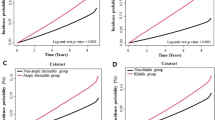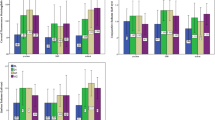Abstract
Purpose
External allergens are the main causative factor in the pathogenesis of allergic diseases; however, little is known about internal factors such as the biometrical structure of the eye. We investigated the relationship between refractive error and allergic conjunctivitis in order to reveal possible insights into the pathogenesis in 1015 subjects.
Methods
The patients were divided into four groups: contact lens wearers with allergic conjunctivitis (n=73), contact lens wearers without allergic conjunctivitis (n=59), non-contact lens wearers with allergic conjunctivitis (n=224), and non-contact lens wearers without allergic conjunctivitis (n=659). The spherical power, cylindrical power, corneal radius, and minimum and maximum corneal refractive powers were measured in all subjects.
Results
In the non-contact lens wearers, the spherical equivalent and spherical power were significantly lower in patients with allergic conjunctivitis than in patients without allergic conjunctivitis (−3.01±3.83 D vs−1.36±3.08 D, P<0.0001, and −2.64±3.63 D vs−1.05±2.88 D, P<0.0001, respectively), while there was no significant difference in any of the parameters between the contact lens wearers with and without allergic conjunctivitis.
Conclusion
Refractive error may be a risk factor for allergic conjunctivitis.
Similar content being viewed by others
Introduction
In recent years, the increasing number of cases of allergic diseases has resulted in a growing social concern. A prevalent idea is that hypersensitivity responses to external allergens such as pollen and house dust are the main causative factors in the development of allergic diseases.1, 2 However, little attention has been given to the internal factors such as the biometrical structure of the eye. This paper introduces the novel concept that refractive error could be responsible for allergic conjunctivitis.
Materials and methods
Subject
This study was performed in accordance with the Helsinki's Declaration of 1975 and its 1983 revision. Institutional Review Board approval and a written informed consent were obtained from each subject. The consecutive patients visiting our outpatient clinic between September 2003 and August 2004 were selected for this study. The subjects were classified into four groups: contact lens wearers with seasonal allergic conjunctivitis (SAC) (73 eyes of 73 patients), contact lens wearers without SAC (59 eyes of 59 patients), non-contact lens wearers with SAC (224 eyes of 224 patients), and non-contact lens wearers without SAC (659 eyes of 659 patients). We excluded participants with a previous history of cataract surgery, corneal refractive surgery, and vernal keratoconjunctivitis. Thus, 1015 patients were included in the present study.
Autorefractive measures
As part of our standardized examination, an automated objective refraction test was performed on each participant with an autokeratorefractometer (KR 3000, TOPCON, Yamagata, Japan). The spherical power, cylindrical power, corneal radius, and minimum and maximum corneal refractive power were measured. The spherical equivalent (sphere+1/2 cylinder) was used to calculate the refractive error. Both the right and left eyes were measured; however, only the right eye was used for analysis purposes.
Definition of seasonal allergic conjunctivitis
Seasonal allergic conjunctivitis was diagnosed by slit-lamp examination by identification of clinical symptoms such as conjunctival follicle, papillae, and redness, and seasonal symptoms such as ocular itching and tearing without proliferative lesions according to the guidelines of diagnosis and treatment of conjunctivitis.3
Statistical analysis
Unpaired Student's t-tests were used to compare the mean values. χ2 tests were used to compare the difference in proportions between the two groups. The level of significance was set at P<0.05. The calculations were carried out using the Stat View statistical software package (Abacus Concepts, Berkeley, CA, USA).
Results
The characteristics of the study population are presented in Table 1. The proportion of contact lens wearers was higher in patients with SAC than in patients without SAC (24.6 vs 8.2%, χ2=49.71, P<0.0001). The mean spherical equivalent of the refractive error and spherical power were significantly lower in patients with SAC than in patients without SAC (−3.62±3.76 D vs −1.69±3.25 D, P<0.0001, −3.23±3.56 D vs −1.37±3.06 D, P<0.0001, respectively, unpaired t-test). In the non-contact lens wearers, significant differences were found in spherical equivalent (−3.01±3.83 D vs −1.36±3.08 D, P<0.0001) and spherical power (−2.64±3.63 D vs −1.05±2.88 D, P<0.0001) between patients with and without SAC. On the contrary, no significant difference was found in cylindrical power, corneal radius, and minimum and maximum corneal refractive power between patients with and without SAC (Table 1). In the contact lens wearers, no statistically significant differences were noted in any of the parameters between patients with and without SAC (Table 1).
In the non-contact lens wearers, the mean spherical equivalent refraction, shown in Figure 1, was lower in patients with SAC than in patients without SAC (P<0.05), except for the group aged between 20 and 39 years. In all patients including contact wearers, similar results were obtained (Figure 2).
Discussion
The relationship between eye shape and allergic conjunctivitis has not been studied so far. Initial studies were conducted to compare the prevalence of allergic conjunctivitis between the contact and non-contact lens wearers. The prevalence of allergic conjunctivitis was higher in the contact lens wearers than in the non-contact lens wearers. This result suggests that allergic conjunctivitis occurs more frequently in the contact lens wearers, as reported previously.4 Next, we attempted to investigate the relationship between the refraction of the eye and allergic conjunctivitis in the non-contact lens wearers to minimize the influence of contact lens-associated conjunctivitis. In the non-contact lens wearers, the mean spherical equivalent and spherical power were significantly lower in patients with SAC than in patients without SAC. In addition, our refraction data pertaining to the non-contact lens wearers without SAC were in excellent agreement with the refraction data of the healthy Asian population.5 These results suggest that with respect to the non-contact lens wearers, patients with SAC are more myopic than healthy individuals. Therefore, the myopia may be relevant in SAC.
A possible drawback of this study is that myopic patients with allergic conjunctivitis are less likely to tolerate contact lens wear and the selective analysis of the non-contact lens wearers is likely to include a significant proportion of myopic allergic patients. Therefore, future study should be designed to overcome this bias induced by contact lens wearer. However, most contact lens wearers were 20–40 years old in the current study; and contrary to expectation, there was no significant difference in refractive error between patients with and without allergic conjunctivitis in the non-contact lens wearers aged between 20 and 39 years. Furthermore, as shown Figure 1, each age group except for the group aged 20–39, showed significant differences in refractive error between patients with and without allergic conjunctivitis, suggesting that allergic conjunctivitis may be associated with refractive error at least in the younger group under 19 years and older group over 40 years.
The first possibility is to assume that the configuration of the corneal surface leads to allergic conjunctivitis. Recent investigations have demonstrated that vernal conjunctivitis, classified under the term allergic conjunctivitis, is related to the abnormal pattern of the corneal surface.6 The abnormal ocular surface deteriorates the capacity of the fluid reservoir over the ocular surface. Tear film anomalies capture allergens in the conjunctival SAC and cause the conjunctival immune-based inflammation by inducing T-cell activation. Thus, refractive error may be a possible risk factor for the direct progression to allergic conjunctivitis. Second, myopic eyes, which have a longer axial eye length and wider palpebral fissures, may be liable to mediate intimate attachment of allergens by the close interaction between bulbar and palpebral conjunctiva. Third, myopia may be indirectly relevant to SAC. Myopia is associated with education levels and socioeconomic factors.5 Moreover, educational level appears to be associated with the risk of allergic sensitization,7 and higher socioeconomic status is associated with high multiple allergen concentrations in house dust.8, 9 High humidity and warm temperature in high-income homes are optimal conditions for mite growth. House dust mites, in particular, multiply in the bed, bedroom carpets, and upholstered furniture under hot and humid atmospheric conditions. Therefore, myopic people with a high-socioeconomic status may be exposed to a high level of allergens. Myopic patients may be prone to suffer from allergic conjunctivitis on account of these factors. However, we cannot comment on the role of myopia due to the limitations of our study.
The question of how refraction and allergic conjunctivitis are actually correlated with each other is still open. Additionally, as compared with the Asian population, our findings may not be applicable to Western populations with a lower prevalence of refractive errors.10 Thus, these considerations invite further empirical investigation concerning the interaction between refraction and allergic conjunctivitis.
References
Mimura T, Yamagami S, Amano S, Funatsu H, Arimoto A, Usui T et al. Allergens in Japanese patients with allergic conjunctivitis in autumn. Eye 2005; 19: 995–999.
Mimura T, Amano S, Funatsu H, Yamagami S, Araie M, Kaji Y et al. Correlations between allergen-specific IgE serum levels in patients with allergic conjunctivitis in Spring. Ocul Immunol Inflamm 2004; 12: 45–51.
Ben Ezra D . Guidelines on the diagnosis and treatment of conjunctivitis. Ocul Immunol Inflamm 1994; 2(Suppl): 17–26.
Suchecki JK, Donshik P, Ehlers WH . Contact lens complications. Ophthalmol Clin North Am 2003; 16: 471–484.
Shimizu N, Nomura H, Ando F, Niino N, Miyake Y, Shimokata H . Refractive errors and factors associated with myopia in an adult Japanese population. Jpn J Ophthalmol 2003; 47: 6–12.
Totan Y, Hepşen IF, Cekiç O, Gündüz A, Aydin E . Incidence of keratoconus in subjects with vernal keratoconjunctivitis: a videokeratographic study. Ophthalmology 2001; 108: 824–827.
Porsbjerg C, Linstow ML, Nepper-Christensen SC, Rasmussen A, Korsgaard J, Nolte H, Greenlandic Population Study Group et al. Allergen sensitization and allergen exposure in Greenlander Inuit residing in Denmark and Greenland. Respir Med 2002; 96: 736–744.
Rosenstreich DL, Eggleston P, Kattan M, Baker D, Slavin RG, Gergen P et al. The role of cockroach allergy and exposure to cockroach allergen in causing morbidity among inner-city children with asthma. N Engl J Med 1997; 336: 1356–1363.
Kitch BT, Chew G, Burge HA, Muilenberg ML, Weiss ST, Platts-Mills TA et al. Socioeconomic predictors of high allergen levels in homes in the greater Boston area. Environ Health Perspect 2000; 108: 301–307.
Saw SM, Katz J, Schein OD, Chew SJ, Chan TK . Epidemiology of myopia. Epidemiol Rev 1996; 18: 175–187.
Acknowledgements
The authors have no commercial or proprietary interest in the product or company described in the current article.
Author information
Authors and Affiliations
Corresponding author
Rights and permissions
About this article
Cite this article
Mimura, T., Mimura, Y., Arimoto, A. et al. Relationship between refraction and allergic conjunctivitis. Eye 23, 63–66 (2009). https://doi.org/10.1038/sj.eye.6702999
Received:
Accepted:
Published:
Issue Date:
DOI: https://doi.org/10.1038/sj.eye.6702999





